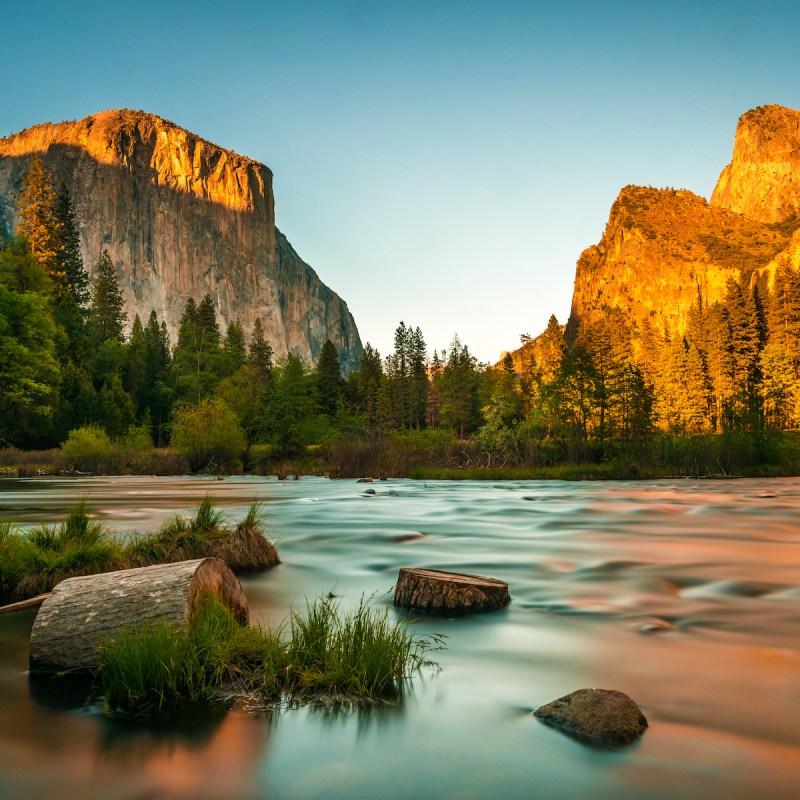
From the steep, granite walls of Half Dome to the endless green expanse of Tuolumne Meadows, Yosemite is among the best-known national parks in the United States. Visitors from all over the world flock to Yosemite to appreciate the epic views and reconnect with nature.
Videos by TravelAwaits
But with that fame come some of the largest crowds in the National Park System. For the past 3 years, the National Park Service has worked to balance the desire of people to see this natural wonder with the need to protect and conserve all within its boundaries. At the same time, massive infrastructure improvements are underway to make future park visits even better. Combined, this means current visits to the park could be challenging.
However, with some research and preparation, Yosemite can still be enjoyed by everyone. Here’s what the experts recommend for a visit in 2023.
1. Reservations Are Not Required For Summer Entry
For the first time in 3 years, no advanced reservations to the park will be needed this summer. Simply arrive, pay your fee, and enjoy the beauty.
Pro Tip: If you’ll be visiting multiple national parks in the U.S. this year, purchase the America the Beautiful pass for just $80 at the entrance. It will admit you to all national parks and monuments for the next 12 months.

2. All Campgrounds Require Advanced Reservations
Yosemite traditionally offered guests the ability to reserve a campsite in advance or claim one in a first come, first served system. That is not the case this year. All campsites must be reserved online in advance. This applies to all seasons.
3. Tuolumne Meadows Campground Is Closed Again
Thanks to the Great American Outdoors Act, Yosemite has been awarded millions of dollars for infrastructure improvements. One of those projects is the renovation of the park’s largest campground in Tuolumne Meadows including plumbing upgrades, leveling of campsites, and new picnic tables and bear boxes.
Unfortunately, this means the campground will not be available to visitors in 2023. But if you’re camping here in 2024, it will be a significantly better place.
4. Make Reservations For Summer Accommodations Now
Yosemite Hospitality offers a wide range of accommodations ranging from upscale hotels to canvas tents. During the summer these lodgings fill up quickly. So if you’re hoping to stay in one of these places, it’s wise to make your reservations right away.
According to Chelsie Layman, director of sales and marketing for Yosemite Hospitality, the most popular hotels like the Ahwahnee book at least 6 months in advance. However, she also points out that due to cancellations, openings can become available closer to your travel dates.

5. The Ahwahnee Hotel Will Look Different This Year
Built in 1927, the Ahwahnee Hotel is one of the best-known and most-loved lodgings in the entire national park system. But it was desperately in need of renovations, so thanks again to the Great American Outdoor Act, it has been closed for over 2 months to get that work started. Projects include seismic retrofitting, new windows, an improved kitchen, and a new HVAC system.
The Ahwahnee Hotel will reopen on March 3, but there will still be ongoing construction. Guests can expect to see scaffolding both inside and out and the dining room will remain closed until May. When completed, this historic property will be far better and safer for guests.
6. Massive Infrastructure Projects Are Underway
Consult The Park’s Website Before Visiting
Additional infrastructure improvements are underway including the repaving and widening of Glacier Point Road, traffic flow improvements in the valley, and upgrades to the parking lot and restrooms of Bridal Veil Falls. Some of these projects will conclude this summer while others will continue through 2023.
Prior to your visit, be sure to consult the park’s website to learn how you can safely access any sights you’d like to see. Or when you arrive, head to one of the visitor centers to ask for a ranger’s advice about moving throughout the park.

7. Every Season Is Spectacular
Of the park’s annual 4.2-4.3 million visitors, most come during the summer. For those with flexibility in their schedule, Scott Gediman — public information officer (PIO) for Yosemite — encourages people to consider coming another time. Winter is the least busy time of year, and yet it’s beautiful to see Yosemite’s iconic sites covered in snow. Spring brings wildflowers, green meadows, and of course, the fabulous colors of fall foliage in autumn.
8. Take It Slow
National parks saw an explosion of interest during the pandemic. Yosemite’s PIO, Scott Gediman, says this is mostly a positive trend, but he does share some concerns. First, he sees people rushing from attraction to attraction, often focused on getting the perfect picture. He encourages visitors to slow down, focus on just a few sights, and spend more time at each one. After 27 years as a park ranger, he still hasn’t seen everything in the park, so visitors certainly won’t do so during a single trip.
Gediman also wants visitors to drive slower while in the park. The number one reason bears are killed in Yosemite is due to speeding drivers. “Whatever you’re doing in the park, do it slower. I promise you’ll enjoy it more.”

9. Consider A Guided Tour
Trying to decide what to see in Yosemite can be daunting. Chelsie Layman recommends the Valley Floor Tour, a 2-hour narrated bus tour that stops at the most popular sights in the park. It’s a great way to enjoy the park while letting someone else drive and park.
If you’re interested in hiking, backpacking, or rock climbing but don’t know where to start (after all there are 750 miles of trails in the park), consider a guided experience with Yosemite Mountaineering School & Guide Service. They know all the best places — and hidden gems — to explore.
10. Come Prepared
No matter what time of year you visit the park and what you decide to do, preparation is key, according to Scott Gediman. Yosemite varies in elevation from 2,000 to 13,000 feet. That means a warm day in the valley could be quite cold at higher elevations. Always bring layers when you’re taking part in any outdoor activity. And if you’re getting away from park services, be sure to pack water, snacks, sunscreen, a hat, and a first aid kit.
